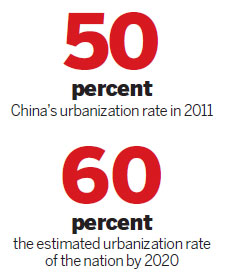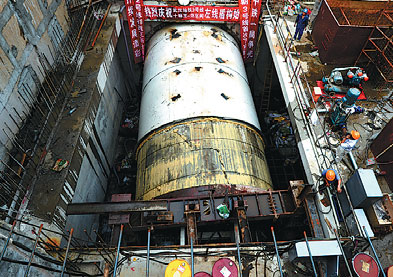Urbanization is backbone of the booming economy
Updated: 2013-01-17 08:11
By Huang Ying (China Daily)
|
||||||||
|
A boring machine begins to tunnel at a construction site for subway Line 3 in Wuhan, capital of Hubei province, on Sept 11. As the city's first subway line linking Hankou and Hanyang, two key areas of the city, the first stage project of the line is expected to open to traffic in 2015. Jin Siliu / for China Daily |
|
A salesman checks masks on a shelf at a drugstore in Chengdu, capital of Sichuan province, on Monday. Sales of masks remained at normal levels even though smog had shrouded the city for days. The city is located in a basin where haze is a constant visitor, especially in winter. Yu Ping / China Daily |

Urban rail development, and medical and other services are likely to lead the Chinese economy in 2013, which is almost certain to be a year of greater growth than 2012 was.
They reflect the stronger-than-ever momentum in the drive for urbanization, and the government's intention to use it as the economy's main powerhouse in the coming decades.
All industries that have something to do with the development of cities and city-based services are poised to grow faster.
So are the companies in these industries - so long as they deliver quality goods and services and stay away from corruption and regulatory offenses.
Urbanization has been a main factor driving the Chinese stock market, as read by the Shanghai Composite Index, to rise more than 18 percent from early December to Wednesday.
In a number of government conferences, Vice-Premier Li Keqiang said he pins high hopes on the potential of urbanization in China.
Many economists argue that urbanization will be the theme of China's change in its business and social horizon over the next decade and beyond, instead of the export-oriented industry, which no longer suffices to generate new growth due to the sluggish global market demand in the post-recession era.
In 2011, the urbanization rate, the proportion of the people living in cities, just passed 50 percent. By 2020, the government aims to have this figure at 60 percent.
In comparison, developed economies in Europe and the United States have an urbanization rate of about 80 percent.
According to a research report by BOC International (China) Ltd, the railway industry will see many new opportunities in the development of high-speed and intercity train services.
Analysts predict the demand for railway construction will occur in the eastern part of the country before it does in the western and central regions.
Demand for transportation facilities will first emerge in first-tier cities, as they have stronger economies and are capable of launching large-scale infrastructure projects, according to CEBM Group Ltd, an independent investment advisory firm.
Urban mass transit and airport construction will have good opportunities for development even with the backdrop of an overall economic slowdown, because the government wants to relieve traffic congestion and provide better transportation services to citizens, according to Guosen Securities Co Ltd.
Liu Heming, a senior official of the Ministry of Housing and Urban-Rural Development, told chinanews.com in the middle of October that 34 cities have mapped out transportation networks stretching up to 4,300 kilometers, involving a total investment of 2 trillion yuan ($320 billion).
In the next 20 to 30 years, rapid urbanization development is expected to continue and the urban mass transit sector will experience its fastest-ever period of growth, Liu was quoted as saying.
Chen Hao, a senior executive at venture capital company Legend Capital, said in an interview with Zero2IPO Research Center that for venture capital and private equities in China, the investment opportunities next year and for an extended period will come from urbanization, and there are three sectors worth paying attention to - modern services, healthcare industries and consumer goods.
By the end of 2025, 70 percent of the Chinese population will live in cities, and in absolute terms - that would be about 900 million to 1 billion, based on the current population. By the end of 2030, more than 220 cities will have populations exceeding 1 million, with an increase of 400 million city dwellers, Chen said.
In Chen's opinion, most of the 400 million new city dwellers will work in and be customers of the service industry. The modern service industry operates with the application of high-tech approaches such as IT and modern management, and therefore has more advantages over the general service industry. Services concerning consumption, production and finance are what he thinks will flourish in the future.
The healthcare industry is more complicated because it involves government administration, medical system reform and business operating systems. The requirements of investors who plan to invest in this field are more demanding.
The healthcare industry has bright prospects with the aging Chinese society. Urbanization will generate greater demand for medical services from the public, Chen said.
In China, the medical equipment industry has exceeded 100 billion yuan with an annual average growth rate of 23 percent. It is estimated that the market scale will reach 340 billion yuan in 2015.
Moreover, medical apparatus only takes up 14 percent of the total medical industry while the figure of the global market has reached 42 percent.
Li Qiushi, an analyst at Guotai Junan Securities Co, said in a research report that urbanization is expected to drive 250 billion yuan growth in the pharmaceutical market.
A report released by Shenyin & Wanguo Securities Co said that as urbanization deepens, the sales of durable consumer items like home appliances, automobiles and furniture will grow and other items such as gas and clothing are expected to increase with the development of people's consumption habits.
Migrant workers who have been urbanized accounted for 23 percent of the urban population in 2011, and the ratio is growing. By the end of the third quarter last year, migrant workers and their family members accounted for 27.5 percent of the urban population.
Lessons from developed economies indicate that the increase of 1 percentage point in the urbanization rate will cause final consumption to improve 1.6 percent.
In the consumer goods sector, listed companies account for 8.4 percent of the A-share market's value, which is rather low in comparison with the rest of the world, Chen said.
The demand for consumer goods will grow along with the reform of income distribution mechanism, and the change of the consumption structure amid the urbanization offers venture capital and private equity a lot of opportunities for investment, according to Chen.
Other city-based services, including smart city-related sectors, energy-saving and environmental protection, are also demonstrating a promising outlook.
Cities that are enabled to operate smarter with the technical support of the Internet of thing - cloud computing, artificial intelligence, data mining and knowledge management - are called smart cities. Industries and companies that provide such services are also worthy of attention when viewing investment.
According to BOC International, as urbanization progresses, a series of problems are expected to arise, such as traffic congestion, worsening of the environment and energy emergencies. Smart cities will be able to deal with all these problems through technology-intensive methods and the application of urban information resources.
The subsectors include intelligent transportation, green intelligent buildings, e-governance systems, energy-saving construction materials and green lighting, according to the reports of investment advisory firms.
Ecological civilization development has been integrated into the general layout of socialism with Chinese characteristics for the first time in the report from the 18th National Congress of the Communist Party of China in November, a sign that can be interpreted as an ambition by the central government to improve the country's environmental and ecological condition.
Bai Pengming, a macroeconomic analyst with the Shenzhen-based CIC Research Center, said energy-saving and green industries have increasingly become one of the necessary approaches for different economies to realize sustainable development under circumstances where resources become limited and environmental conditions deteriorate.
Zhang Yang, an analyst from Sinolink Securities Co Ltd, told China Business News newspaper that the new urbanization deserves to be a hot topic for investors in the long run, and probably weighs more than the previous financial reform in significance, because it covers more aspects and has a more widespread effect than the financial reform.
huangying@chinadaily.com.cn
(China Daily 01/17/2013 page7)

 In Photos: 7.0-magnitude quake hits Sichuan
In Photos: 7.0-magnitude quake hits Sichuan
 Li Na on Time cover, makes influential 100 list
Li Na on Time cover, makes influential 100 list
 FBI releases photos of 2 Boston bombings suspects
FBI releases photos of 2 Boston bombings suspects
 World's wackiest hairstyles
World's wackiest hairstyles
 Sandstorms strike Northwest China
Sandstorms strike Northwest China
 Never-seen photos of Madonna on display
Never-seen photos of Madonna on display
 H7N9 outbreak linked to waterfowl migration
H7N9 outbreak linked to waterfowl migration
 Dozens feared dead in Texas plant blast
Dozens feared dead in Texas plant blast
Most Viewed
Editor's Picks

|

|

|

|

|

|
Today's Top News
Live report: 7.0-magnitude quake hits Sichuan, heavy casualties feared
Boston suspect cornered on boat
Cross-talk artist helps to spread the word
'Green' awareness levels drop in Beijing
Palace Museum spruces up
First couple on Time's list of most influential
H7N9 flu transmission studied
Trading channels 'need to broaden'
US Weekly

|

|









